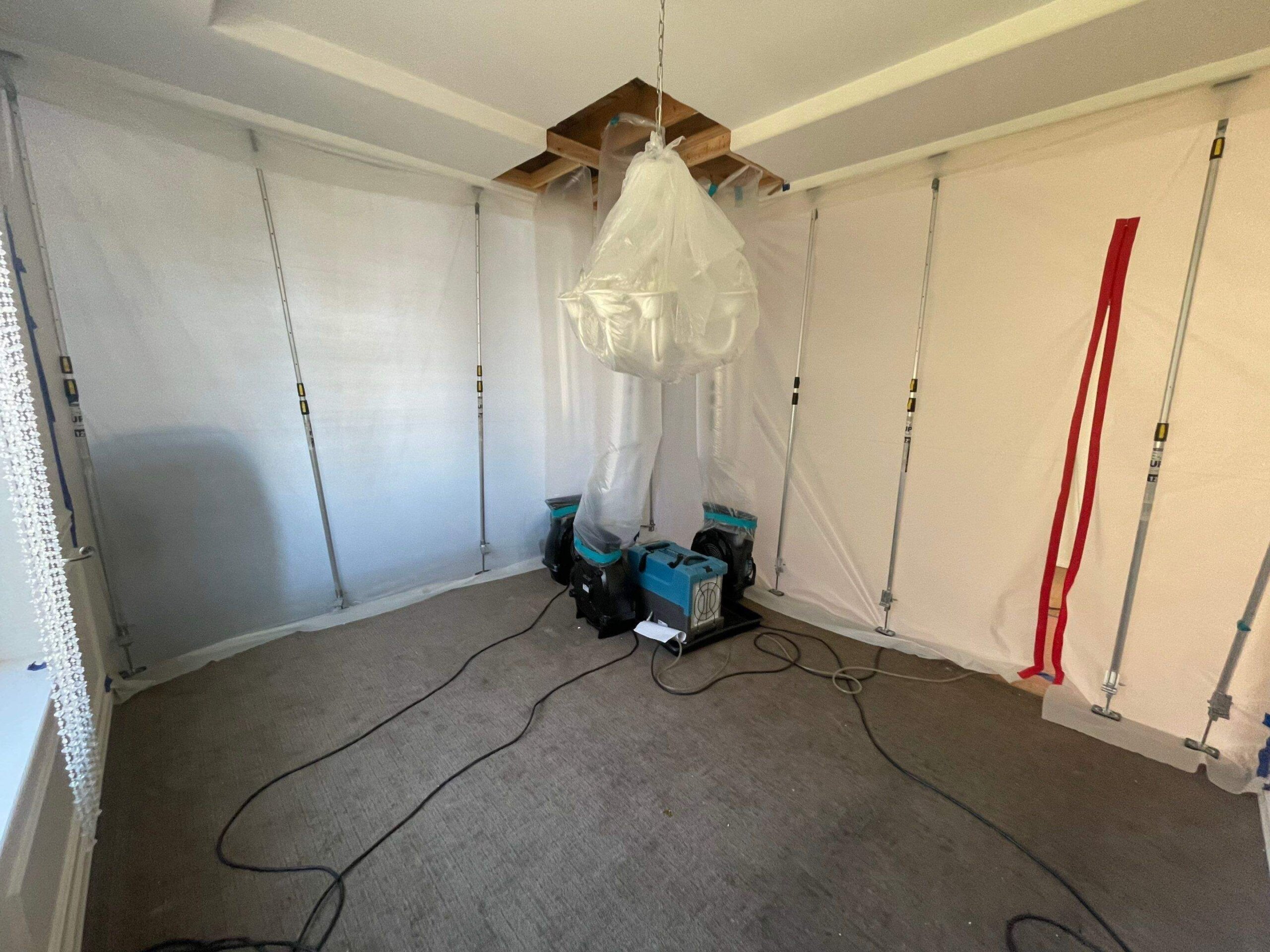- 24/7 EMERGENCY WATER DAMAGE SERVICE

Water damage can cause damage to your ceilings, causing a range of issues. One problem that homeowners could face is buckled or bubbled ceilings from water damage. It’s a scary and unsightly situation to deal with, but understanding the causes and signs of water damage is crucial for effective repairs.
Imagine this scenario: you notice a small stain or bubble on your ceiling that keeps growing over time. It starts off as just a minor issue but over time grows and presents itself as a health hazard, as well as it could be the result of moisture seeping in from an initial leak. If the water damage is left unaddressed, this moisture can weaken the structural integrity of your ceiling, leading to buckling and sagging.
Identifying the signs of water damage early on is essential. Whether it’s a small hole, discoloration, bubbling or sagging on your ceiling, these indicators shouldn’t be ignored.
Leaking roofs or pipes are common culprits for ceiling water damage. These issues can lead to significant problems if left unaddressed. Here are some signs that indicate your ceiling may have suffered water damage:
In addition to these visual cues, there are other indicators that point towards ceiling water damage:
By being vigilant and recognizing these signs, you can take prompt action to address any potential issues with your ceiling before they worsen. Remember, early detection and timely repairs are crucial in preventing further and more costly damage and maintaining a safe living environment.
So, if you suspect any form of ceiling water damage—such as visible stains, sagging or drooping sections, discoloration, mold growth, or musty odors—it’s essential to promptly seek professional assistance for assessment and repairs. Don’t ignore these warning signs; act swiftly to protect your home from further harm.
Inspecting your roof regularly is crucial in preventing water damage to your ceilings. Look out for any signs of leaks or damaged shingles that could allow water to seep into your home. Here are a few things to keep in mind:
Proper insulation in your attic plays a significant role in preventing condensation buildup, which can lead to water damage on your ceilings. Take these steps to ensure adequate insulation:
Having functional gutters and downspouts is essential for directing water away from your home’s foundation and preventing it from seeping into the ceilings. Follow these tips:
By following these preventive measures, you can significantly reduce the risk of buckled ceilings caused by water damage. Regular inspections, proper insulation, and well-maintained gutters are key steps towards keeping your ceilings dry and intact.
Start by identifying the source of the leak and fixing it promptly. Leaks can come from various places, such as a burst pipe or a roof leak. Once you’ve located the source, take immediate action to stop the water from causing further damage. (When Determining Source: Please be aware that any outside water that has come into contact with debris, materials, or organic substances is considered contaminated and unsafe for human consumption or immersion.)
Use supportive braces to stabilize the sagging area before making repairs. Sagging ceilings can be dangerous if left untreated, so it’s important to provide temporary support to prevent any potential accidents. Braces can be made using sturdy materials like wood or metal and should be placed strategically to reinforce the weakened ceiling.
Replace damaged drywall or plaster, ensuring a smooth finish with joint compound. After stabilizing the ceiling, it’s time to address the visible damage. Remove any wet or damaged sections of drywall or plaster and replace them with new materials. Make sure to cut out the affected area in a neat shape for easier patching.
Apply joint compound over the repaired areas and sand it down for a seamless finish. Joint compound is used to fill in gaps and create a smooth surface on repaired drywall or plaster. Apply multiple thin layers, allowing each layer to dry before adding another. You want the end result to be so smooth the transition is undetectable. Sand down any rough spots until you achieve a seamless result.
Paint over the repaired section to match your existing ceiling color. Once all repairs are complete and dried, it’s time for some finishing touches. Choose paint that matches your ceiling color and carefully apply it over the repaired section using a brush or roller.
By following these steps diligently, you can fix your buckled ceiling from water damage effectively. Remember that safety should always be prioritized when dealing with sagging ceilings, so don’t hesitate to seek professional help if needed.
Before repainting your buckled ceiling from water damage, it’s important to take a few necessary steps to ensure a successful repair. Here are some helpful tips to guide you through the process:
Repairing water-damaged ceilings requires attention to detail and careful execution of each step involved in the process. By following these tips and utilizing appropriate materials, you can restore your ceiling to its former glory while preventing future issues. Remember, taking immediate action is key to minimizing repair costs and preserving the integrity of your home.
Discoloration, water spots, stains, and mildew can be unsightly reminders of water damage on your ceiling. But fear not! There are steps you can take to address these issues and restore the beauty of your ceiling. Here’s what you need to do:
By following these steps, you can effectively address discoloration and stains caused by water damage on your ceiling. Remember to prioritize proper ventilation when working with bleach solutions and consult professionals if needed for accurate color matching and choosing suitable primers.
Now that you know how to tackle this issue head-on, say goodbye to those unsightly marks on your ceiling!
Now that you understand the causes, signs, prevention methods, and steps to fix water-damaged ceilings, it’s time to take action. Don’t let a buckled ceiling from water damage bring down the aesthetics and safety of your home. Armed with this knowledge, you can confidently address any issues that arise.
To get started, assess the extent of the damage and determine if you’re comfortable tackling the repairs yourself or if it’s best to call in a professional. Remember to prioritize safety by wearing protective gear and ensuring the area is properly ventilated. Follow the step-by-step guide we provided earlier and utilize our tips for repairing water-damaged ceilings effectively.
Don’t delay addressing water damage on your ceiling. The longer you wait, the worse it can become. Take control of the situation today and restore your ceiling to its former glory!
Painting over a water-damaged ceiling without addressing the underlying issue is not recommended as it may lead to further problems. It’s crucial to identify and repair the source of water damage before considering any cosmetic fixes.
The drying time for a sagging ceiling depends on various factors such as humidity levels, ventilation, and extent of water damage. It typically takes several days or even weeks for a damp ceiling to completely dry out.
Not necessarily. In some cases, localized repairs may be sufficient. However, extensive or recurring damage may require replacing larger sections or even the entire affected area.
Absolutely! Regularly inspecting your roof for leaks, maintaining proper ventilation in attics, bathrooms and kitchens, and promptly addressing any plumbing issues can significantly reduce the risk of water damage on your ceilings.
It depends on the severity of the damage and your comfort level with DIY projects. While minor repairs can often be done by homeowners, extensive or complex damage may require the expertise of a professional contractor to ensure a proper fix.
I think my roof is leaking, who do I call?
We are not professional roofers but we know one! True Blue Roofing is a great company who does VERY good work at competitive prices, this is who our brand partners with https://trueblueroofs.com/
If you’re dealing with a wet or filthy carpet in your home or business,
don’t hesitate to contact Premier Water Removal.
Why Choose

Our expert team is trained and experienced in dealing with all types of mold, and we use advanced equipment and techniques to effectively remove it from your home or business. We will work closely with you to assess the situation and determine the best course of action to take.
Fill Out The Form Below
🔒 We will not sell your information or spam you. Privacy policy
About us
Since 1998, Premier Emergency Water Removal has been helping property owners In The Greater Seattle Area recover from flood damage and water emergencies.
Contact Us
Copyright © 2025 Premier Emergency Water Removal. All Rights Reserved.